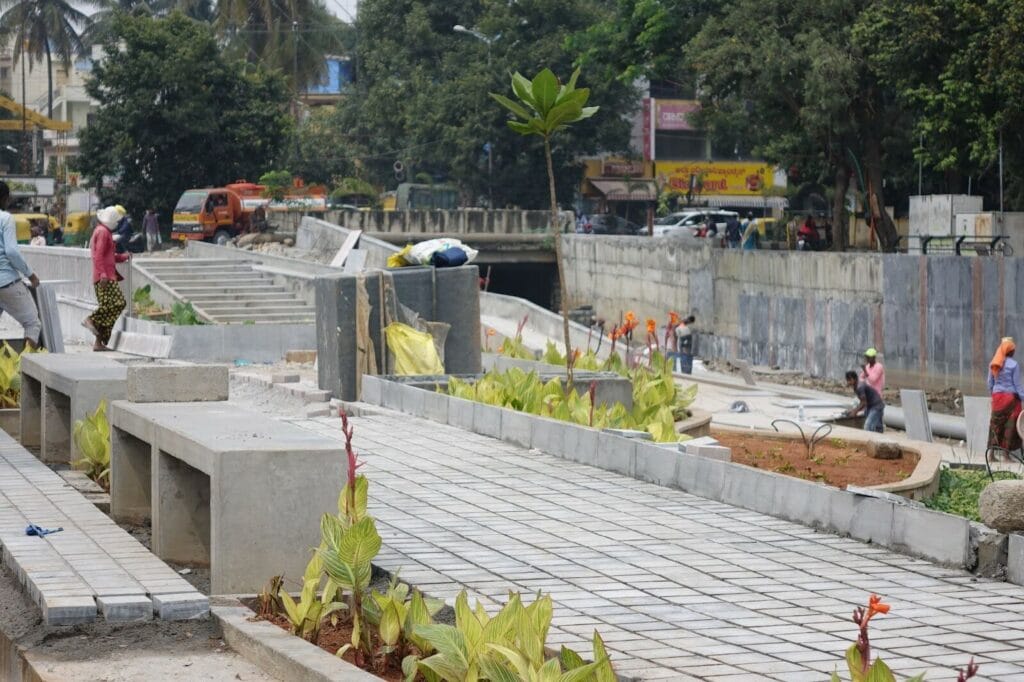Showers break 150-day hot spell
Sources from the India Meteorological Department (IMD) had said that dry weather may prevail in the city till May 5th, but light showers on May 2nd brought relief. It had been a zero rainfall month in April, a first since 1983 – and one of the longest dry spells of nearly 150 days since November 2023.
The rains also brought in the usual issues of water logging, power outages and traffic bottlenecks.
May Day was the hottest of the month so far in 40 years, touching 38.1 degrees Celsius. Kempegowda International Airport showed the highest temperature of 39.2 degrees Celsius. In April, with 38.5 degrees Celsius, the city faced the second-hottest day in at least 50 years, after the hottest was recorded in April 2016 at 39.2 degrees Celsius. At least 10 days last month recorded 3.1-5 degrees Celsius above normal temperatures, according to experts.
Source: The Hindustan Times, The Times of India, Deccan Herald
Read more: BBMP budget 2024-25: Allocations and climate action plan in conflict
Drive to increase lifespan of trees
The ‘Cool Tree’ campaign to protect trees has been launched by 20 to 30 enthusiasts from the Bengaluru Hudugaru green group. The drive is to counter the ills of the rising heat and reduced groundwater, which has affected several trees, creating termite infestations and stunted growth.
Every Sunday, the team covers the trees with a white coating, composed of a mixture of protective chemicals, including Befenthrin, Malathion or Organophosphate, neem oil, white powder and wheat flour for adhesion, as suggested by a BBMP forest range officer.
Vinod Kartavya, founder of Bengaluru Hudugaru, explained that the excessive heat holds back the water in the stem and does not let it reach the branches. Termites make it worse as they feed on the moisture in the tree. This catalyses the rotting process and leads to its early decay, reducing the lifespan of a tree by about 30-35 years. Hence, removing termites and applying the white coat helps to protect the trees and improve its longevity.
More than 200 trees have been coated with the white mixture after removing termites in the past month in Yelahanka, Indiranagar, Nagarabhavi, and Shanthala Nagar.
Source: Indian Express, newskarnataka.com
Struggling with water woes
The city’s declining water levels are due to rapid surface-level evaporation and the absence of rain, according to Dr T V Ramachandra, coordinator of the Energy and Wetlands Research Group at the Indian Institute of Science (IISc).
To counter the reducing water levels, the Bangalore Water Supply and Sewerage Board (BWSSB) and Bruhat Bengaluru Mahanagara Palike (BBMP) are drilling new borewells, creating mounds of soil, blocking the road and polluting the air. One resident of Horamavu Agara complained that they had to pay Rs. 2,000 to call two tractors to clear the debris.
BWSSB sources admitted that they drilled over 200 borewells but the soil debris left behind by borewell-drilling was not of good quality. Hence, they let the soil dry on empty land on the outskirts. The agency used stone dust to refill damaged edges of manholes, pipelines and trenches. The city produces nearly 3,000 tonnes of construction waste every day.
A 2016 rule that mandated Sewage Treatment Plants (STPs) to be built and maintained in all apartments with more than 20 units created 2,600 decentralised plants across the city. The existing STPs generate 700 MLD of treated water. The BWSSB announced that it will buy the treated water and supply to establishments through tankers.
Two weeks ago, the BWSSB adopted the treatment of waste water technology developed by the Indian Institute of Science. It now produces 1 crore litres of treated water. Many IT companies have given a positive response and Wipro is buying the treated water everyday.
So far, about six lakh aerators have been installed across the city. From May 8th, BWSSB Chairman Ramprasat Manohar V, directed officials to identify and penalise establishments that have failed to install the mandated aerators.
Source: Deccan Herald, The Hindu
Read more: Neglected, polluted lakes of Peenya: Insights from data
Koramangala Valley waterway by Aug 15th
The BBMP plans to complete the Koramangala valley waterway project on August 15th to make it sewage free. Engineers have been asked to locate private establishments that release the sewage directly into the valley. So far, the sewage flow into the valley has been reduced by 97%, said BS Prahlad, BBMP’s engineer-in-chief.

The BBMP had conceptualised the Rs. 175-crore plan for the K-100 valley in 2021. Various hurdles related to sewage flow management put up obstacles in the completion of the project by mid-2023. Hence, the BBMP and BWSSB started two new works to ensure that only clean and treated water could be permitted into the stream — a Rs. 4.42 crore sewer line between Hosur Road and Neelasandra Junction and a 15-MLD intermediary wastewater pumping station.
Meanwhile, the BBMP has also taken up massive cleaning of storm water drains from Challaghatta Valley flowing from East to Southeast Bengaluru.
Source: Deccan Herald, The New Indian Express
LED project revived
The BBMP aims to install 5,00,000 LED streetlights in the city after three years, replacing sodium vapour bulbs. It is expected to reduce the BBMP’s annual electricity bill to Rs. 86.31 crore, which is a three-fold decrease.
However, the higher maintenance costs for the LED system might reduce the net financial gain. Still, baseline survey across seven zones shows that LED streetlights might reduce electricity consumption.
Currently, the BBMP pays about Rs. 256 crore per annum to Bescom as electricity charges, while Rs. 53.15 crore are paid towards repairs and maintenance of streetlights. If LED bulbs get installed, the bill might decline to Rs. 86.31 crore, yet maintenance will increase to Rs. 95.59 crore, that is almost two times more. Still, the new scheme might fetch Rs. 181 crore to BBMP every year.
Source: Deccan Herald
[Compiled by Revathi Siva Kumar]